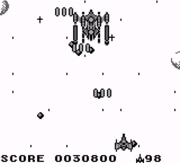Software:SolarStriker
| Solar Striker | |
|---|---|
 Cover art | |
| Developer(s) | Minakuchi Engineering Nintendo R&D1 |
| Publisher(s) | Nintendo |
| Director(s) | Satoru Okada Keisuke Terasaki[1] |
| Producer(s) | Gunpei Yokoi[1] |
| Designer(s) | K. Hayashi A. Higashiya K. Katsuyama K. Yamagami[1] |
| Programmer(s) | K. Sugimoto[1] |
| Composer(s) | Toru Osada[2] |
| Platform(s) | Game Boy |
| Release | |
| Genre(s) | Shoot 'em up |
| Mode(s) | Single-player |
Solar Striker (ソーラーストライカー) is a vertical scrolling shooter video game developed by Nintendo R&D1 with Minakuchi Engineering for the Nintendo Game Boy. It was first published in Japan on January 26, 1990, then released later in North America in February, and finally in Europe on September 28.
Gameplay
As a game that only has single player mode, the player controls the advanced space fighter, code-named Solar Striker. There are six levels of play against enemies known as the forces of Reticulon. These enemies appear from the top of the screen. Special ships can be shot and power-ups can be obtained. One power-up means twice the firepower. Three power-ups mean three times the firepower. Five power-ups means big blasts on enemies which are helpful, especially against tough enemies and bosses that take many hits to destroy. There are a variety of enemies as well as sub-bosses in the later levels. They descend in patterns and bosses have their own way to try to defeat the player. When the player completes all six levels for the first time and after the credits roll, the player will be able to play Hard Mode by pressing Select instead of Start from the title screen.
Plot
"The year is 2159. The Earth Federal Government was established, linking the people with a common government against other species. As part of this new addition and to defend the human race's peace and safety, the Earth Federal Army was also created."
"The army went on the offensive, and attacked a star known as 'Turin.' However, the Earth Federal Army was no match for the overwhelming combat power of Turin, and Earth's fate seemed sealed. As Earth's last chance, a top-secret mobile unit developed a very advanced space fighter in Earth's last fortification. Flying with the mothership, 'Mother Atena', it arrived at Turin's solar system as the last chance for a violent and final attack on the Turin forces. This advanced spacecraft, and Earth's last hope for survival, is code-named 'Solar Striker'."[3]
Development and reception
Solar Striker was designed by Gunpei Yokoi and Keisuke Terasaki,[1] and developed by Nintendo in co-operation with the external company Minakuchi Engineering. It was first published in Japan on January 26, 1990, then released later in North America in February, and finally in Europe on September 28. As such, it is one of the few scrolling shooters developed by Nintendo.
Solar Striker has been met with generally favorable reviews. It earned an overall score of 75% at GameRankings. Mean Machines described Solar Striker as "adequate", but noted there was a lack of material to keep players interested, giving the game a score of 69%.[4] Allgame rated it 2.5/5, describing it as a "decent shooter but nothing great", and citing its difficulty as a deterrent to enjoying it.[5] Games Are Fun gave it a 7 out of 10. German magazine Power Play praised the title for its variety in terms of enemies and levels, though noted the underlying simplicity of the game as well, giving it a score of 70%.[6] Author Jeff Rovin in the book How to Win at Game Boy Games described the title as "one of the oldest kinds of Nintendo games", comparing it to SNK's Alpha Mission but added there were too few instances of innovation or surprises, and the powerups were "unsatisfying".[7]
Appearances in other media
- The background music for Level 1 and Level 2 was used in the beginning of the Captain N: The Game Master episode, "The Trouble With Tetris", in a slightly altered form. A space craft seen in the same part of the episode resembles the Solar Striker on the Japanese box art of the game. In fact, the Level 1 background music was also used in later season 2 episodes of Captain N: The Game Master.
References
- ↑ 1.0 1.1 1.2 1.3 1.4 "N-Sider.com: Solar Striker". N-Sider. December 24, 2007. http://www.n-sider.com/gameview.php?gameid=284&view=credits. Retrieved 2007-12-24.
- ↑ Mobygames
- ↑ "ソーラーストライカー". Nintendo Co. Ltd. https://www.nintendo.co.jp/n02/dmg/ssa/index.html. Retrieved 2007-11-01.
- ↑ Rignall, Julian; Matt Regan (November 1990). "Solar Striker Review". Mean Machines (7). http://www.meanmachinesmag.co.uk/review/42/solar-striker.php. Retrieved 2009-06-04.
- ↑ Sutyak, Jonathan. "SolarStriker - Review". Allgame. All Media Group. http://allgame.com/game.php?id=12203&tab=review. Retrieved 2009-06-04.
- ↑ "Solar Striker for Game Boy - MobyRank". MobyGames. http://www.mobygames.com/game/gameboy/solar-striker/mobyrank. Retrieved 2009-06-04.
- ↑ Rovin, Jeff (1991). How to Win at Game Boy Games. Signet Books. p. 160. ISBN 0-451-17446-1.
External links
- Official Japanese website (Translated using Excite.Co.Jp)
- Official Japanese instructions in PDF format
- SolarStriker at MobyGames
- Solar Striker at NinDB


